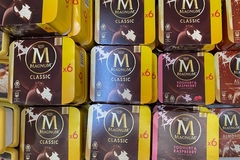
- Industry news
Industry news
- Category news
Category news
- Reports
- Key trends
- Multimedia
- Journal
- Events
- Suppliers
- Home
- Industry news
Industry news
- Category news
Category news
- Reports
- Key trends
- Multimedia
- Events
- Suppliers
Cargill installs entire chocolate development cycle under one roof in Belgium

01 Jun 2022 --- Cargill has strengthened its position in rapid chocolate development and consumer-centric gourmet offerings with the grand opening of the House of Chocolate. The new end-to-end center is located in Mouscron, Belgium, alongside its existing chocolate production plant and a stone’s throw away from its cake and chocolates decorations business.
The facility is being positioned as the first-of-its-kind in Europe, and, perhaps, in the world.
FoodIngredientsFirst attended the exclusive opening event on-site, where consumer insights, master classes, R&D, sensory testing, and pilot production are now centered under one roof. Cargill’s expertise in sugar, sweeteners and edible oils will also merge to help slash product development time.
To inaugurate the building, Cargill took stakeholders and press on a tour dubbed “Expedition Chocolate,” where attendees “traveled” by plane and boat to arrive at the House of Chocolate.

“Innovation is an expedition – it’s exploring,” Inge Demeyere, managing director, chocolate Europe tells FoodIngredientsFirst.
“You go through ups and downs and you don’t know exactly what will come. There’s no straight line to the final product.”
Demeyere is credited for conceptualizing the House of Chocolate after seeing a need in the market.
 Attendees were taken on an “expedition” to discover the House of Chocolate. Inge Demeyere is seated in the front row (left) next to the mayor of Mouscron, Brigitte Aubert. An accelerated journey
Attendees were taken on an “expedition” to discover the House of Chocolate. Inge Demeyere is seated in the front row (left) next to the mayor of Mouscron, Brigitte Aubert. An accelerated journey
The building is designed to take customers through every stage of product development.
Sample products can then be turned around in as little as one or two days in the mini production facility, which has been created to replicate industrial-scale processing. This setup avoids the need to tweak recipes again when scaling up with the use of different processes or equipment.
“We bring customers to us early in the innovation cycle, and that’s part of what makes this concept unique," she says.
"For inspiration, we have market insights and trends we discuss along with their ideas and our innovations. From there, we can immediately elaborate a solution in the demo kitchen the same day as well as sensory testing.”
“One step closer to the consumer”
Demeyere shares that the House of Chocolate fully fits into the company’s food strategy to go more toward added-value businesses.
"It began with the execution of Cargill’s gourmet business, which started in 2006 with the Veliche brand," she says.
.jpg) Three-Michelin-starred chef Tim Boury crafted cocoa-seasoned veal cheeks in combination with Belgian cheese and a savory chocolate sauce for the event.Beefing up its gourmet portfolio, Cargill acquired Smet, Leman – and has now opened the House of Chocolate.
Three-Michelin-starred chef Tim Boury crafted cocoa-seasoned veal cheeks in combination with Belgian cheese and a savory chocolate sauce for the event.Beefing up its gourmet portfolio, Cargill acquired Smet, Leman – and has now opened the House of Chocolate.
“These moves are exactly in line with Cargill’s added-value strategy,” says Demeyere, which brings the company closer to the consumer.
“The gourmet business goes to chocolatiers and chefs, so it’s still B2B, but these customers are in close contact with the end consumer. And the end consumer is where we start when it comes to product development.”
Going gourmet Demonstrating its culinary prowess and out-of-the-box applications, Cargill brought on board three-Michelin-starred chef Tim Boury to create two savory chocolate concepts for the House of Chocolate’s big day.
One was cocoa-seasoned veal cheeks wrapped in capsicum flowers in combination with Belgian cheese and savory chocolate sauce. The other was a crispy taco made with Okapi Signature Origins chocolate from the Congo filled with roasted beetroot brushed with chocolate and black garlic cream.
Neither creation presented the classic chocolate taste that consumers quickly associate with confectionery applications, but offered earthy, spicy, savory notes and deeper dimensions to the dishes.
“Much more to come”
Although chocolate is a mature market in Europe, Demeyere anticipates “endless possibilities” in product development.
“There are a lot of innovations coming in, such as the crunchy texture. If you now look at cereals, there are a lot of chocolates in them, whereas five years ago you did not find that. The form and shape of the chocolates are also showing more variation,” she says.
 Cargill’s gourmet business began with its Veliche brand, offering premium Belgian chocolate.She also points out there are more colors coming into chocolate, such as caramel and extra white.
Cargill’s gourmet business began with its Veliche brand, offering premium Belgian chocolate.She also points out there are more colors coming into chocolate, such as caramel and extra white.
“We are not at the end stage with just dark, milk and white chocolates,” she muses.
Visual cues are also freshening up traditional mainstays, such as Belgium’s Bûche De Noël (a log-shaped sponge cake), with new colors and shapes to top off the holiday specialty.
Built for infinity
Looking ahead, Demeyere affirms the House of Chocolate is built for the future with the capacity to infinitely improve, keeping a close ear to the ground to consumer trends.
“There are a lot of innovations in the exploration phase, which will come further, such as the health trend,” she underscores.
“People look at what is good for the body more and more. Right now, you don’t yet have a lot of people talking about sugar-reduced chocolate.”
“So this is a trend which is still in the beginning phase, but I’m sure that in the coming five to ten years, we will have more chocolate [on the market] with less sugar.”
She also highlights the vegan trend, which is gaining traction although still quite small in the realm of chocolate.
“Vegan is not too strong in chocolate yet, but it will certainly come as it did in restaurants. Just five years ago, it wasn’t standard to have vegan options on the menu, but today they do,” she says.
By Missy Green










